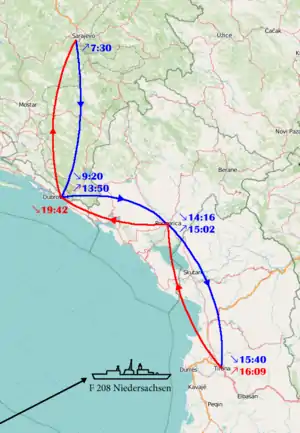Operation Libelle
Operation Libelle ("Dragonfly" in German) was an evacuation operation of the German Armed Forces that took place on March 14, 1997 in the Albanian capital of Tirana during the Albanian Civil War. In the same week, American,[1] British,[2] and Italian military forces evacuated their citizens from Albania. Operation Libelle was the first time since World War II that German infantry fired shots in combat.[3]
| Operation Dragonfly | |||||||
|---|---|---|---|---|---|---|---|
| Part of the Albanian Civil War | |||||||
 Map showing the route of the German helicopters | |||||||
| |||||||
| Belligerents | |||||||
|
| Albanian Insurgents | ||||||
| Commanders and leaders | |||||||
|
| Unknown | ||||||
| Strength | |||||||
| > about 100 men | Unknown | ||||||
| Casualties and losses | |||||||
|
No casualties 1 helicopter damaged |
Unknown number of insurgents wounded No reported deaths | ||||||
| Part of the |
| 1997 Albanian civil unrest |
|---|
| Fighting groups |
| Gangs of 1997 |
| Massacres in 1997 |
| Tragedies of 1997 |
| Treasury thefts |
| Rescue missions |
|
| UN Resolutions |
| Important events |
| See also |
Situation in Albania
In March 1997 several Western states evacuated their citizens. Operation Libelle was launched after a fraudulent pyramid scheme collapsed and a significant number of Albanian citizens lost their life savings. As a consequence, an armed rebellion took hold in large parts of Albania, and the Albanian government lost control.[4]
The crisis eventually culminated in the Albanian Civil War. After the Military of Albania and police armories were looted by insurgents, criminals, and civilians, large parts of the country descended into chaos and violence.[5]
Legal basis
The Federal Republic of Germany relied on the recognized doctrine "right to rescue nationals". There have been allegations, that this doctrine of international law suffers from insufficient State practice. Because of the urgency that arose when in March 1997 German citizens barricaded themselves in the German Embassy in Tirana, Albania, the executive of the German government did not seek parliamentary approval, which was required according to the German Federal Constitutional Court. In a judgement from 1994, the German Federal Constitutional Court held that any foreign deployment of German military personnel for combat or peacekeeping requires the consent of the Bundestag, that is the German federal parliament.[6]
Timeline
March 13
- On the eve of the operation, the German Minister of Defence, Volker Rühe, decided to reduce the reaction time of German Forces in case of emergency in Albania and ordered the frigate Niedersachsen to enter Albanian waters.
March 14
- Five CH-53G heavy transport helicopters with 89 soldiers from the German SFOR contingent headed from Bosnia to Dubrovnik, Croatia. At the same time in Germany, three C-160 transport planes had been held in readiness to fly to the Balkans. The Niedersachsen waited in readiness in the port of Durrës, Albania.
- 11.30 am - The German Government under Chancellor Helmut Kohl decided to deploy German Forces to evacuate the embassy. Because the German military cannot operate abroad without a permission of the German Parliament, the Government employed emergency rules and only informed the leaders of the parliament and the Defence Committee about the planned operation. The C-160s flew to Podgorica, Montenegro. The task force, consisting of CH-53s and soldiers from combat, supporting, and medical units, lifted off to Tirana.
- 3.39 pm - Although American Forces had cancelled a separate evacuation operation in Tirana after a UH-60 Black Hawk helicopter was hit by small arms fire, Colonel Glawatz decided to continue the approach. The first CH-53 landed on an abandoned airfield near the outskirts of Tirana. Perimeter security was established and the civilians started to board the helicopters. Insurgents in armoured personnel carrier approached the area and attacked the escaping civilians. As the German units returned fire, additional gunmen opened fire from the edge of the air strip. At least 188 rounds were fired at the evacuation force, and one CH-53 helicopter was hit and lightly damaged.[7] At least one Albanian was wounded.[8]
- 4.09 pm - the last helicopter left Tirana.
- The helicopters returned to Montenegro with the refugees after the successful end of the operation; they were then transported to Germany.[9]
List of evacuated persons
| Country | Number | |
|---|---|---|
| Germany | 22 | |
| Hungary | 14 | |
| Japan | 13 | |
| Austria | 11 | |
| Czech Republic | 5 | |
| Denmark | 3 | |
| Peru | 3 | |
| Switzerland | 3 | |
| Egypt | 2 | |
| Albania | 2 | |
| Bosnia and Herzegovina | 2 | |
| Netherlands | 2 | |
| Poland | 2 | |
| Others | 8 | |
References
- "USIA - Transcript: DOD Briefing on Evacuations from Albania, 97-03-14". www.hri.org. Retrieved 2017-12-30.
- Roberts, John (2009). Safeguarding the Nation: The Story of the Modern Royal Navy, 352pp, Seaforth Publishing, ISBN 978 1 84832 043 7
- RP Online
- Tom Ruys (2010). 'Armed Attack' and Article 51 of the UN Charter: Evolutions in Customary Law and Practice. Cambridge University Press. pp. 231–232. ISBN 9781139494830.
- "Political Unrest in Albania". PBS NewsHour. Retrieved 30 December 2017.
- Dieter Fleck, ed. (2018). The Handbook of the Law of Visiting Forces. Oxford University Press. p. 45. ISBN 9780198808404.
- Operation "Libelle" Tirana '97: Das erste Gefecht der Bundeswehr RP Online, 14 March 2007
- Laurin, Carin (2005). Baltic Yearbook of International Law, 2005 Martinus Nijhoff Publishers, p. 71, ISBN 9004147888
- "Evacuations from Albania proceed amid a hail of bullets". CNN. 14 March 1997. Retrieved 2017-12-30.